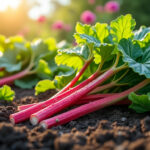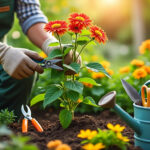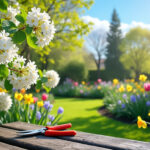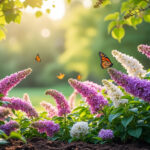As the seasons change, our outdoor spaces begin to buzz with life, marking an invitation to reimagine our gardens. Each bloom, from vibrant snowdrops to striking daffodils, reminds us of nature’s beauty and resilience. Yet, as we embark on this gardening journey, it’s crucial to reflect on how much time and effort we’re willing to invest in maintaining our green havens. Instead of succumbing to the traditional tasks of tedious pruning and watering, why not explore innovative landscaping solutions that promise both charm and ease? In this piece, we delve deep into effective and low-maintenance options for transforming areas beneath trees, where grass struggles to thrive, into breathtaking landscapes brimming with life. By 2025, the aim is to create lush, sustainable gardens without overburdening ourselves. Let’s uncover practical ideas that cater to shade-friendly gardens, providing exquisite beauty with minimal effort.
Strategies for Thriving Gardens Beneath Trees
Gardens beneath trees can be challenging due to limited sunlight and competition for nutrients. Nevertheless, there are numerous strategies to enhance these shaded areas, making them not just functional but also visually captivating. Implementing the right techniques can result in thriving landscapes that require less maintenance, creating a sustainable environment.
Embrace Companion Planting for Enhanced Growth
Companion planting is a technique where plants are grouped together for mutual benefit, which can significantly ease the maintenance burden. By pairing herbs like basil with tomatoes or marigolds with vegetables, the ecosystem within your garden thrives. This method not only promotes pest control but also enhances soil health.
By fostering a symbiotic relationship among plants, gardeners benefit from natural pest resistance and better growth rates.
- 🌱 Benefits of Companion Planting:
- Reduces need for chemical pesticides.
- Encourages beneficial insects, boosting pollination.
- Preserves soil nutrients for better plant health.
Utilizing TreeGuard and SoilShield Products
Products like TreeGuard and SoilShield can revolutionize the way we manage shade-friendly landscapes. TreeGuard safeguards the delicate roots of your trees while ensuring that surrounding plants have enough nutrients and moisture to thrive. SoilShield enhances soil structure, promoting healthier plants that naturally resist pests and diseases. By integrating such products into your garden plan, you can create a thriving ecosystem below the canopy.
Additionally, choosing plants that naturally pair with tree roots helps create a robust foundation for both trees and underplanted areas.
Designing Eco-Friendly Rain Gardens
Incorporating rain gardens is an excellent solution for shaded areas where water often collects. By channeling excess rainwater, these gardens not only prevent flooding but also support biodiversity. Plants like swamp milkweed and certain Iris varieties thrive in these wet spots, providing essential habitats for insects and birds.
As you design your rain garden, prioritize native plants that adapt naturally to local conditions. Native species typically require less maintenance, offering resilience against pests and diseases. Additionally, they provide ecological advantages by supporting local wildlife.
- 💧 Key Plants for Rain Gardens:
- Swamp milkweed 🌾
- Aquatic sedges 🌱
- Bog goldenrod 🌼
Implementing Efficient Drip Irrigation Systems
Another low-maintenance method worth considering is installing a drip irrigation system. This technique ensures that plants receive consistent moisture while minimizing water waste. It’s particularly beneficial for trees and the surrounding plants that thrive in shaded environments. An initial setup might take a few hours, but once established, it requires little to no intervention.
Connect your drip system to a rain barrel to enhance water conservation. By collecting natural rainwater, you reduce dependency on municipal supplies, contributing to a more sustainable garden.
- 💧 Drip Irrigation Advantages:
- Reduces water consumption 💦
- Prevents fungal growth by keeping leaves dry 🌿
- Delivers precise moisture to roots 🌳
Designing Ground Cover Alternatives to Traditional Grass
Creating shade-friendly areas doesn’t have to include traditional lawns, which can be resource-intensive. Instead, a shift towards ground cover plants can enhance the garden while contributing to local biodiversity. These low-growing plants require less upkeep and can thrive in the shade, creating a vibrant carpet of green beneath trees.
Exploring Low-Maintenance Ground Cover Options
Ground cover plants provide an excellent alternative to conventional grass lawns. Species like creeping thyme or clover are better adapted to shaded conditions and require less water and maintenance compared to traditional grass.
Not only do these plants provide covering, but they also support pollinators and reduce soil erosion.
- 🌼 Top Ground Cover Plants for Shade:
- Thyme 🌿
- Clover 🍀
- Vinca minor (periwinkle) 🌸
Incorporating Shade-Friendly Landscape Designs
Shade-friendly landscapes can be beautifully designed to capture attention while minimizing maintenance. Use stone pathways bordered by colorful ground cover, creating visual interest without the challenges of managing a traditional lawn.
The integration of paths and stones allows for ease of access while promoting natural drainage and reducing water pooling.
| Design Element | Benefit |
|---|---|
| Ground Cover Plants | Low maintenance 🌼 |
| Stone Pathways | Improves drainage and access 🚶♀️ |
| Native Flowers | Supports local pollinators 🦋 |
Choosing Native Plants for Sustainable Gardening
Native plants require fewer resources since they have adapted to local conditions over time. They flourish in their native environments, effectively attracting local wildlife and pollinators. By emphasizing native planting, you contribute to enhancing your yard’s overall health and sustainability.
Regarding shade, there are numerous native plants to consider integrating into your designs. These plants will not only beautify your garden but will also require less maintenance, making your life easier.
- 🌳 Benefits of Native Plants:
- Less need for fertilizers and pesticides 🧪
- Supports local ecosystems and wildlife 🌎
- Promotes resilience against pests and diseases 🦠
Hortify: The App You Need for Expert Garden Planning
Eco-Friendly Hardscaping Solutions for Shade Areas
Hardscaping serves an essential role in any garden design, particularly in shaded areas. Choosing permeable materials allows water and nutrients to penetrate the soil while enhancing the overall look of your outdoor space. By focusing on eco-friendly hardscape options, you can elevate your garden aesthetics while ensuring the health of your plants.
Incorporating Permeable Hardscape Elements
Traditional hard surfaces often contribute to drainage issues and can lead to flooding in heavy rain. Instead, consider using permeable materials like gravel or permeable pavers, which facilitate water movement into the soil.
This not only aids in better moisture management but also allows plant roots to spread more freely, which is crucial for trees and underplants.
- 🏗️ Benefits of Permeable Hardscaping:
- Reduces runoff and erosion 🌧️
- Allows for natural water filtration 💧
- Enhances soil health and plant growth 🌱
Creative Use of Natural Materials
In the pursuit of better landscape solutions, combining organic materials such as wood and stone can add a rustic charm to shady garden spaces. A blend of these natural elements encourages wildlife to thrive and stabilizes the soil, particularly in areas prone to erosion around tree roots.
Consider integrating materials like logs or stone boulders for sitting areas or borders to add visual intrigue without complicating maintenance.
| Hardscape Material | Environmental Benefit |
|---|---|
| Gravel Paths | Drains water naturally 🌧️ |
| Naturally Sourced Timber | Supports local ecosystems 🌱 |
| Stone Bordering | Prevents soil erosion 🏞️ |
Creating Spaces for Wildlife
Wildlife habitats are vital for a healthy garden ecosystem. Incorporating features like birdhouses, butterfly gardens, and insect hotels can enrich these shaded spaces. By providing food, shelter, and water, you can encourage animals to thrive, contributing to the overall balance of your landscape.
In addition, native plants serve as food sources for various species, further promoting vitality within your garden. Through strategic planting and thoughtful design, you can create a sanctuary that sustains local wildlife.
- 🦋 Wildlife Support Features:
- Birdhouses for nesting 🕊️
- Sheltered corners for butterflies 🦋
- Water features for insects and birds 💦
FAQs
1. What are the best plants for areas beneath trees?
Choose shade-tolerant plants like ferns, hostas, and various ground covers that thrive in low sunlight.
2. How can I attract more wildlife to my yard?
Incorporate native plants, bird feeders, and water sources to create a hospitable environment.
3. What is the benefit of using permeable materials for landscaping?
Permeable materials help manage water and prevent flooding, enhancing the soil’s health and promoting root growth.
4. Are drip irrigation systems difficult to set up?
Drip irrigation systems can be user-friendly and manageable, making them an excellent investment for low-maintenance gardens.
5. How do I know if a plant is native to my area?
Consult local horticultural guides or universities specializing in native plants for your region.















